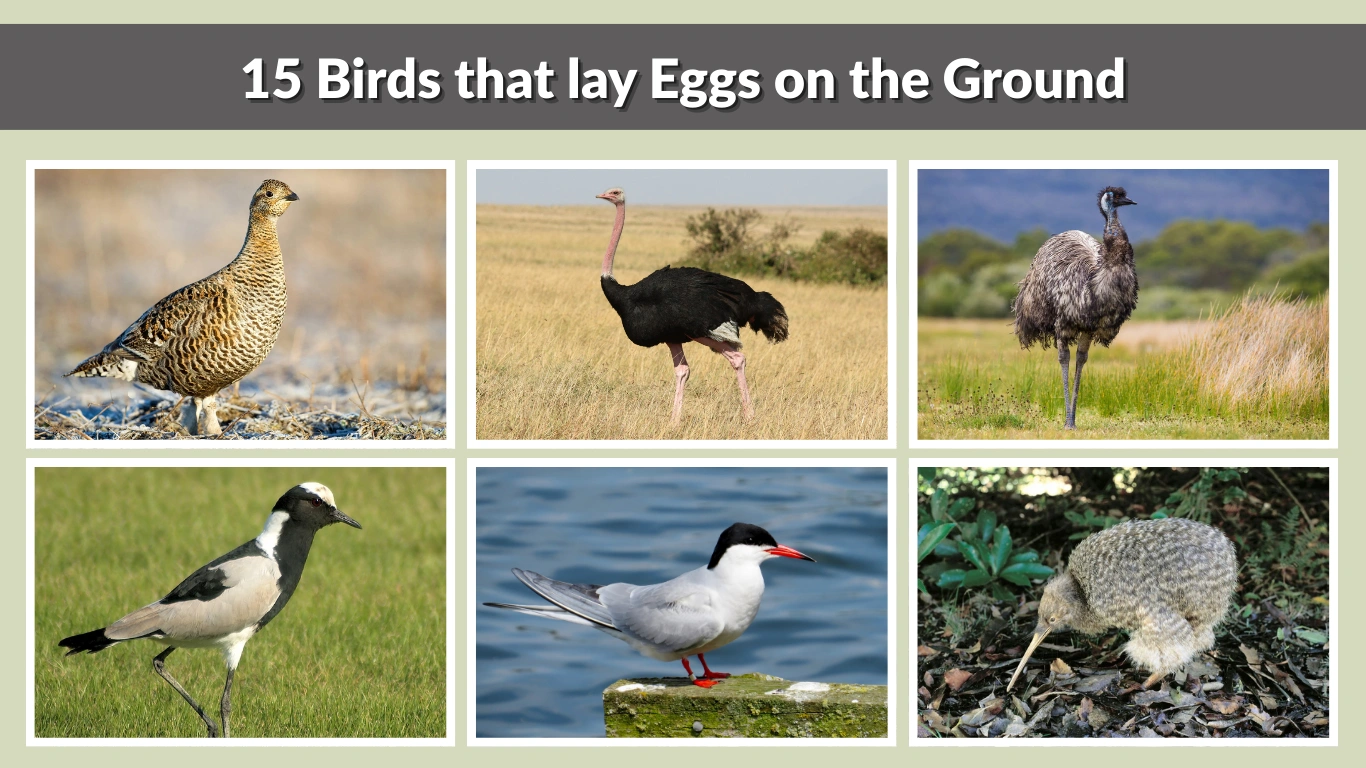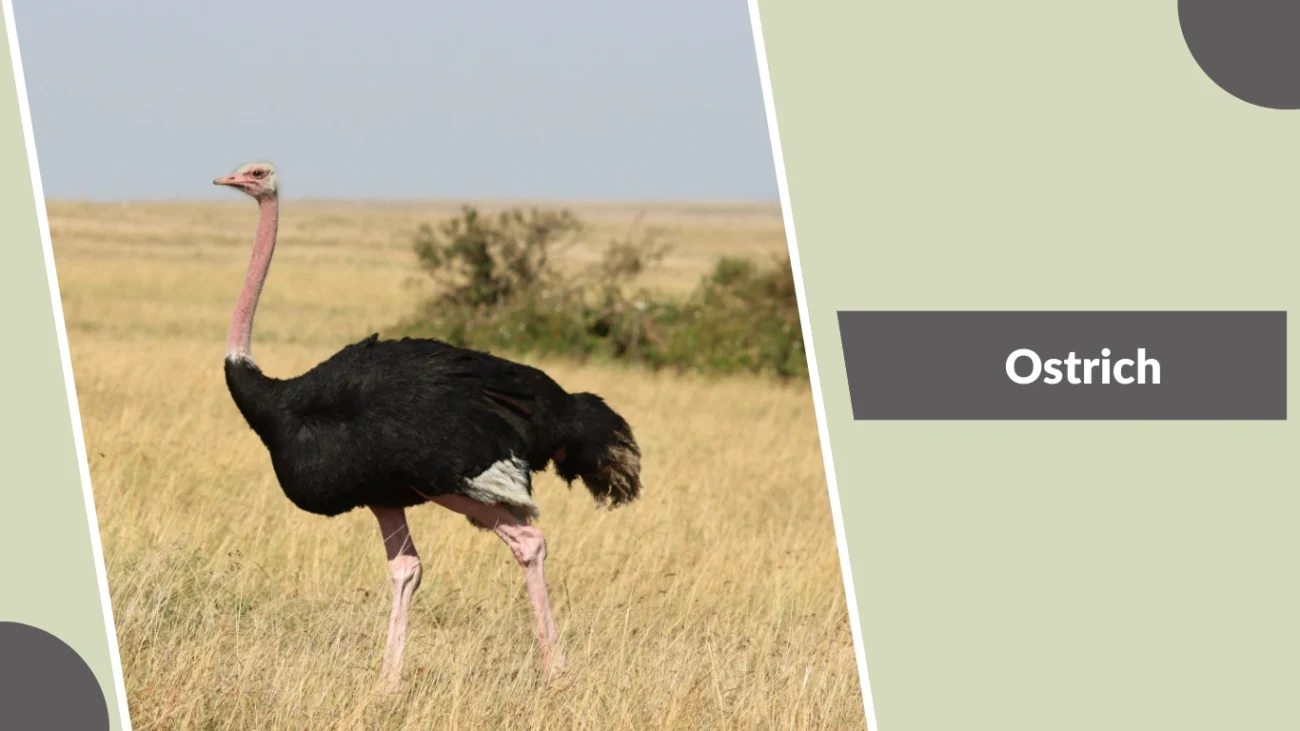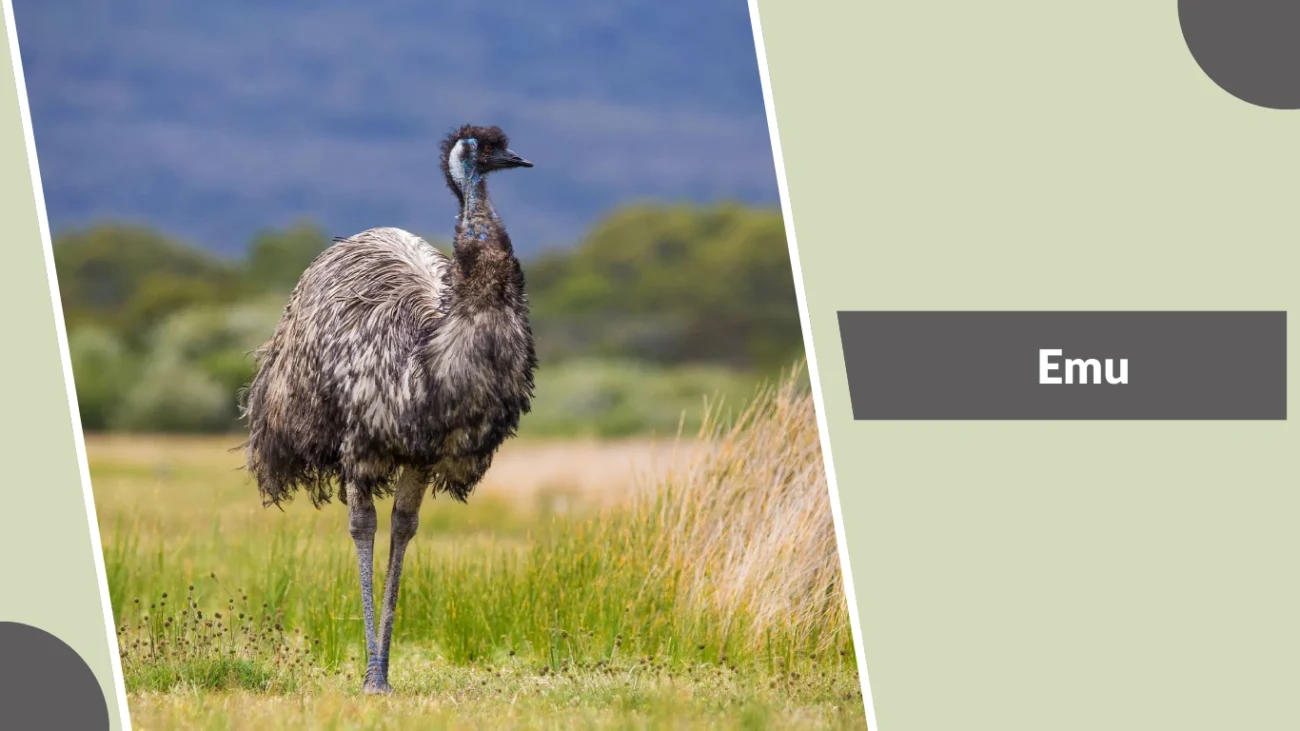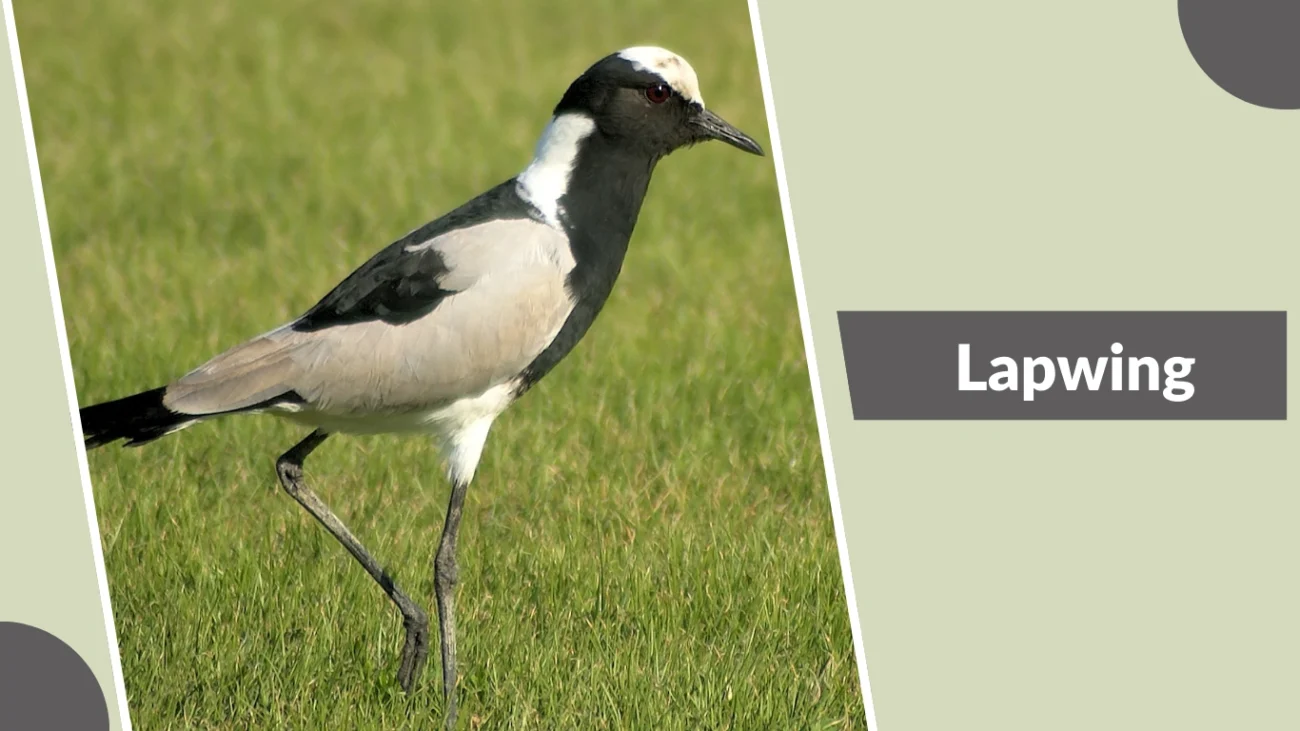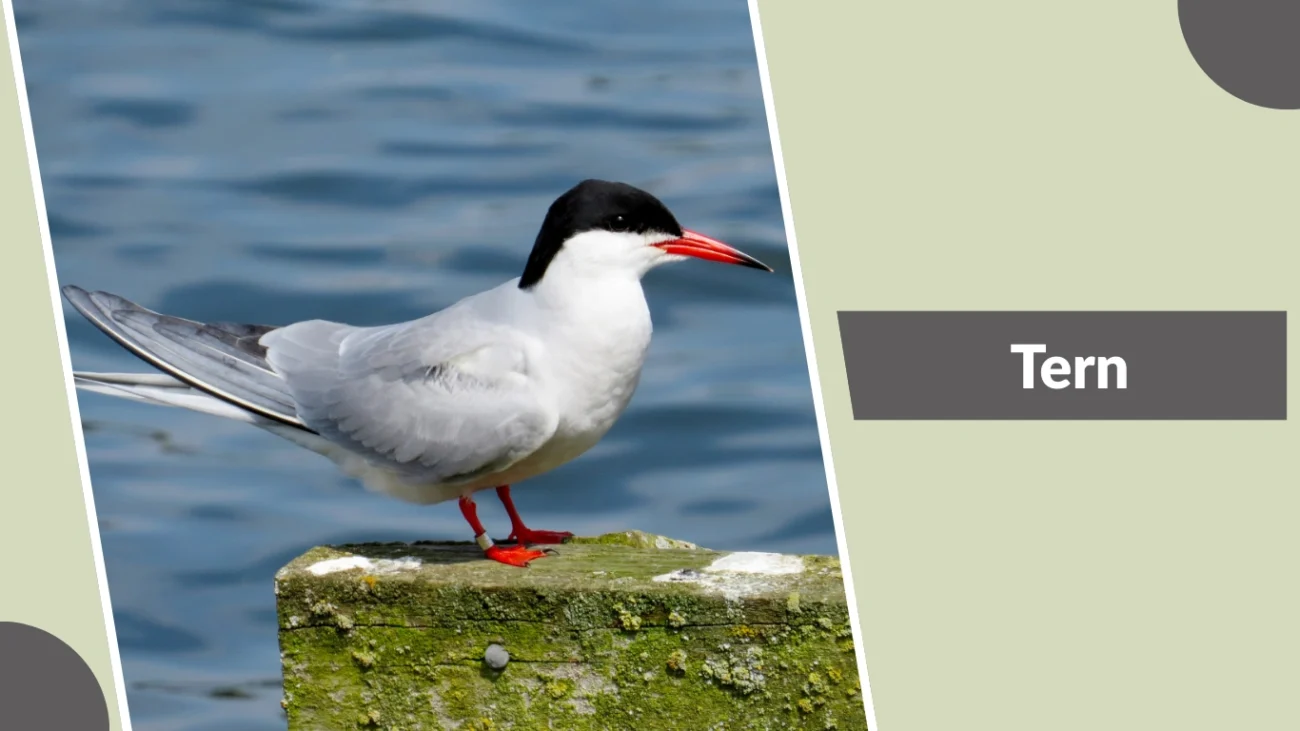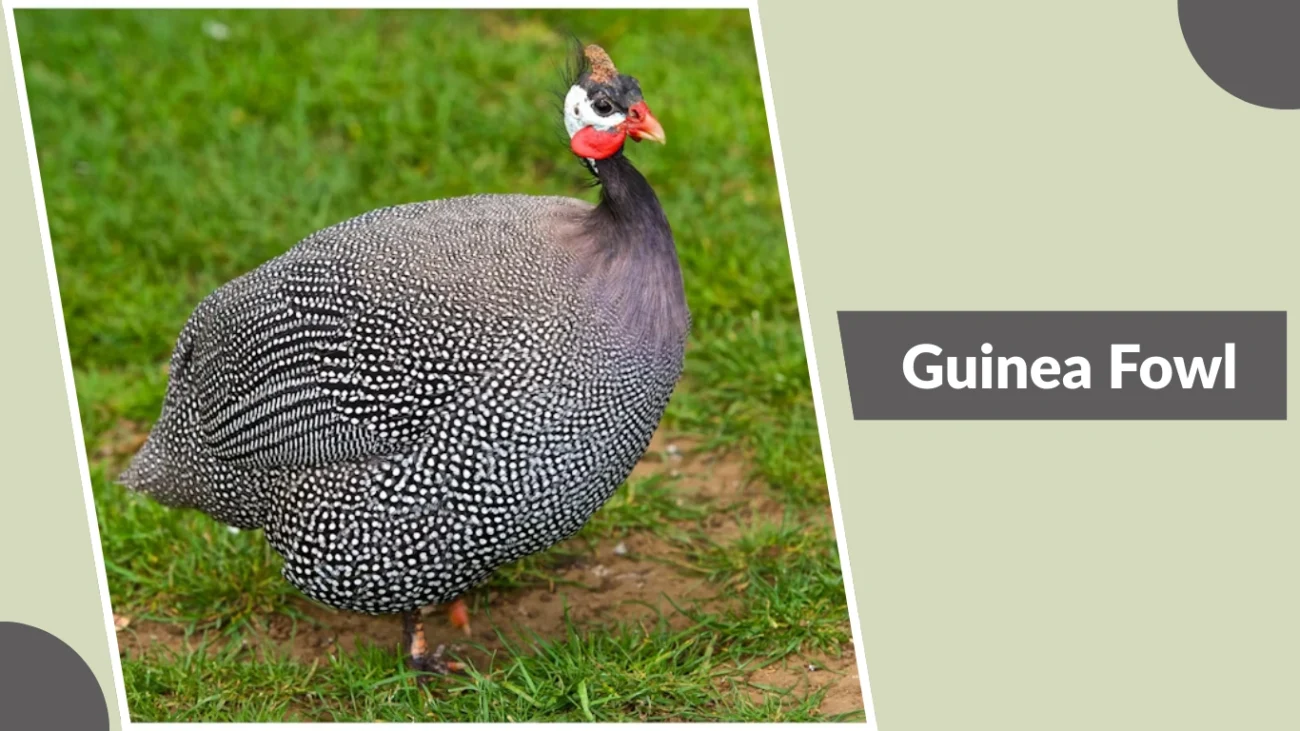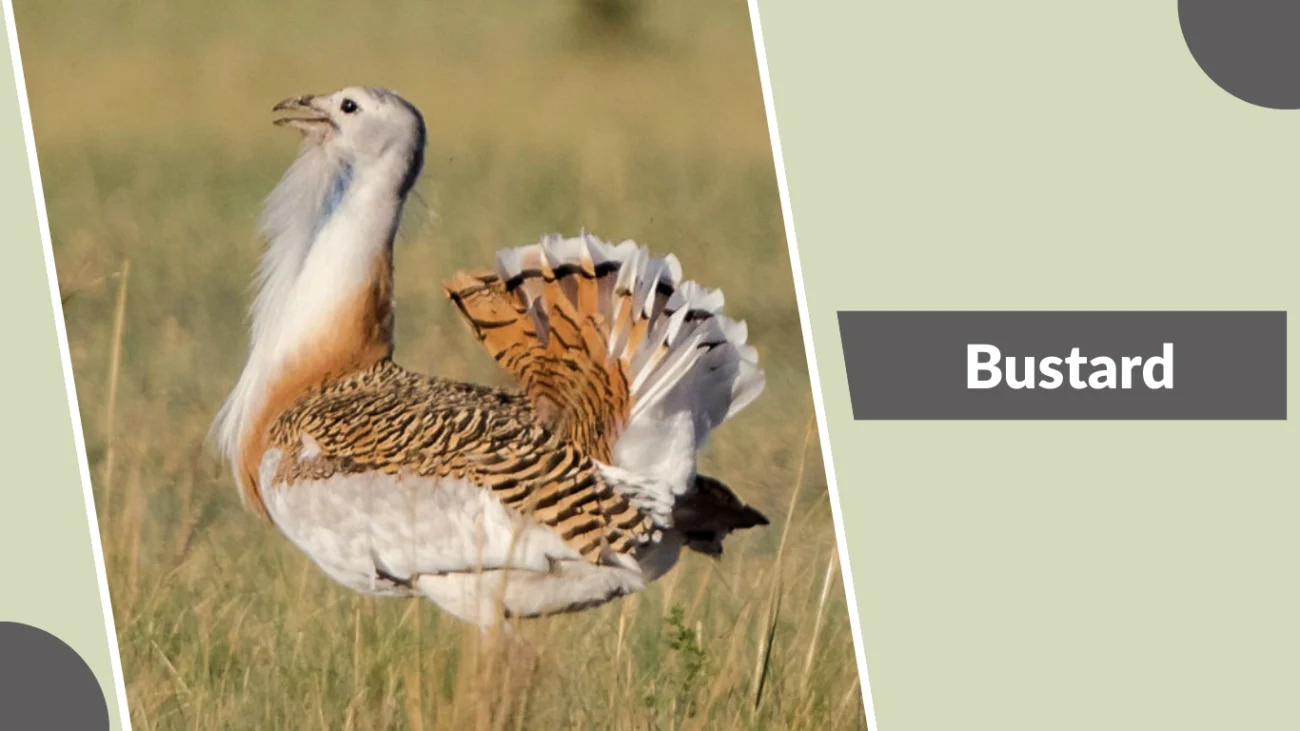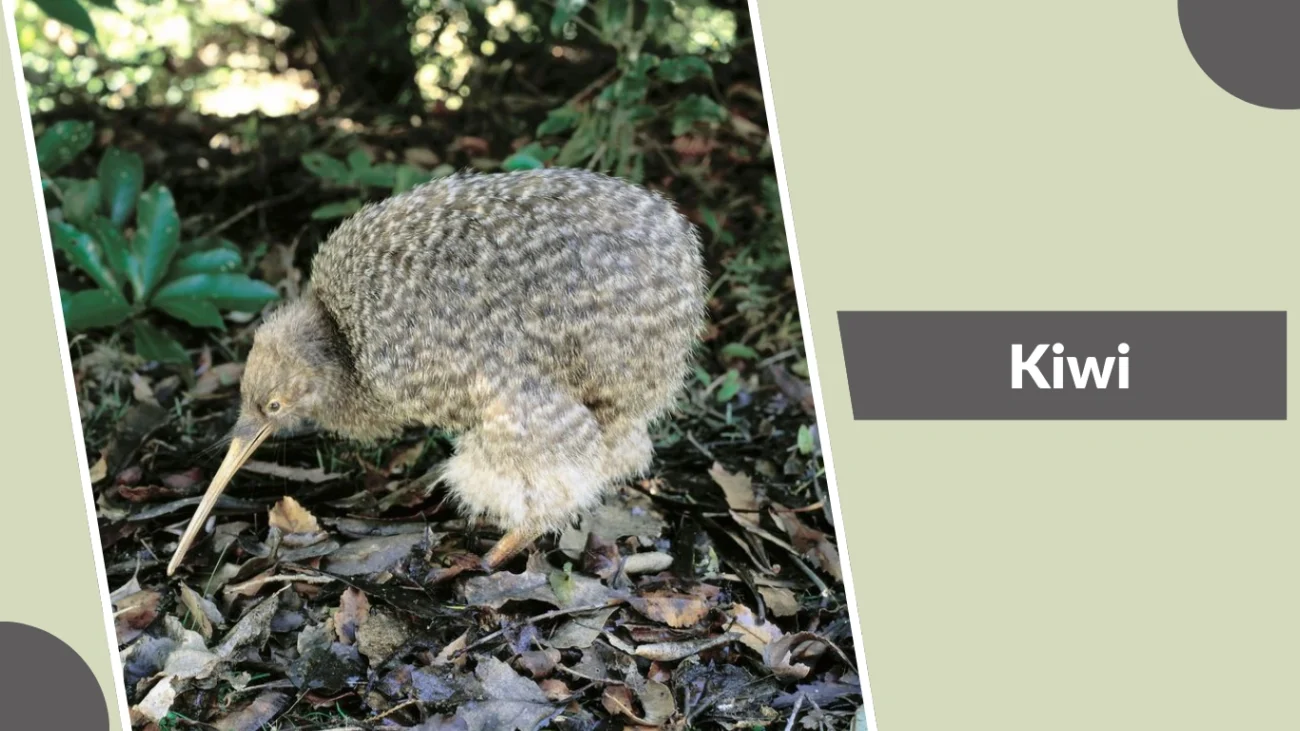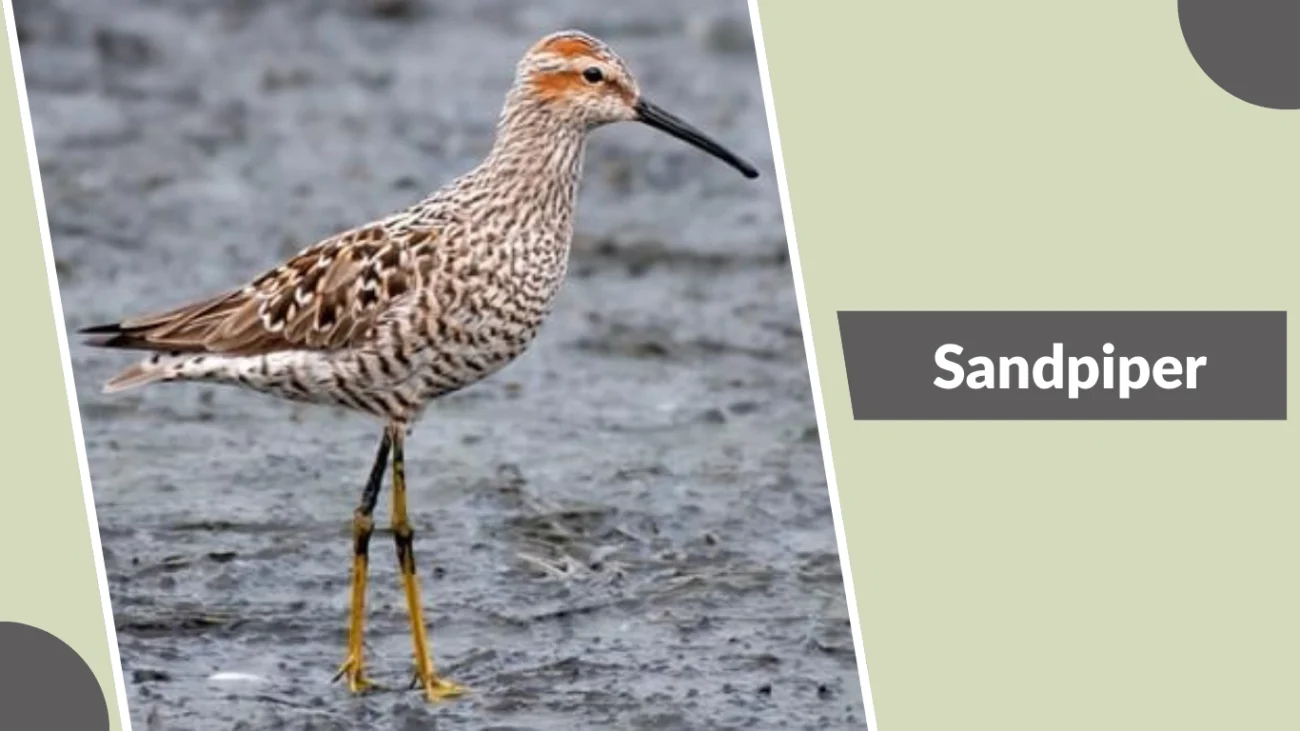Many bird species prefer nesting directly on the ground instead of building nests in trees. These ground-nesting birds rely on camouflage, clever behaviors, and hidden habitats to protect their eggs and chicks. From the tiny lark to the towering ostrich, each bird has unique adaptations that make this strategy successful. In this article, we’ll explore 15 fascinating birds that lay eggs on the ground, highlighting their traits, habitats, and importance.
1. Killdeer
The Killdeer is a widespread plover species found across North and Central America. Known for its distinctive call and ground-nesting habits, it often lays its eggs in open areas like gravel, sand, or even lawns and driveways. Its camouflage eggs blend seamlessly with the surroundings, making them difficult for predators to spot.
Identification
- Size: About 20–28 cm long
- Color: Brown upperparts with white underparts
- Markings: Two bold black bands across the chest
- Legs: Long and slender, adapted for running
- Distinct trait: Loud “kill-deer” call, from which its name is derived
Habitat
Killdeer prefer open habitats such as fields, shorelines, grasslands, and even urban areas. They often choose bare ground, gravel patches, or sandy soil for nesting.
Behavior
This bird is famous for its “broken-wing display,” where it feigns injury to lure predators away from its nest. It is highly territorial during the breeding season and defends its nesting site aggressively.
Importance
Killdeer play an important role in controlling insect populations, feeding on beetles, grasshoppers, and other small invertebrates. Their adaptability to human-modified landscapes has allowed them to thrive in both rural and urban environments.
2. Common Nighthawk
The Common Nighthawk is a nocturnal bird found across North and South America. It is known for its aerial acrobatics during feeding and distinctive “booming” courtship dives. Unlike many birds, it lays its eggs directly on bare ground, rooftops, or gravel without building a nest, relying on excellent camouflage for protection.
Identification
- Size: Around 22–25 cm long
- Color: Mottled gray, brown, and white for perfect camouflage
- Wings: Long and pointed with a noticeable white patch
- Tail: Short and slightly notched
- Distinct trait: Large mouth for catching flying insects, paired with cryptic plumage
Habitat
Common Nighthawks choose open habitats like grasslands, gravelly riverbeds, forest clearings, and urban rooftops. Their nesting sites are usually flat surfaces with little or no vegetation, making their eggs nearly invisible against the background.
Behavior
They are crepuscular and nocturnal, most active at dawn and dusk. During breeding, males perform steep dives accompanied by a loud “boom” made by their wings. Nighthawks do not construct nests; instead, they lay 1–2 eggs directly on soil, sand, or stones. Their cryptic plumage helps both adults and eggs avoid detection by predators.
Importance
Common Nighthawks are important insect predators, consuming moths, beetles, and other flying insects. Their presence helps maintain ecological balance, and their ability to adapt to urban environments makes them a familiar sight in cities during summer evenings.
3. Ostrich
The Ostrich is the world’s largest bird, native to Africa. Despite being flightless, it is known for its incredible speed and powerful legs, which help it survive in open savannas and deserts. Ostriches lay their eggs directly in shallow ground scrapes, where several females may contribute to a communal nest.
Identification
- Size: Up to 2.7 meters tall and weighing 100–150 kg
- Color: Males are black with white wing and tail feathers; females are grayish-brown
- Legs: Long, bare, and strong, ending with two toes
- Neck: Long and flexible with sparse feathers
- Distinct trait: Largest eggs of any living bird, weighing about 1.4 kg each
Habitat
Ostriches are found in open grasslands, dry plains, and deserts across Africa. They prefer wide, open spaces that allow them to spot predators from a distance and run at high speeds if threatened.
Behavior
Ostriches live in small groups and display strong social structures during breeding. The dominant female and male share incubation duties, with the female sitting by day (due to her camouflaged plumage) and the male at night. Ostriches rely on their speed, reaching up to 70 km/h, to escape predators rather than hiding.
Importance
Ostriches play an important role in seed dispersal and maintaining balance in grassland ecosystems. Their eggs are highly nutritious and have historically been valued by humans. Additionally, ostrich farming has become significant worldwide for meat, leather, and feathers.
4. Emu
The Emu is the second-largest living bird, native to Australia. Like the ostrich, it is flightless but adapted for running at high speeds across open landscapes. Emus lay their eggs directly on the ground in a shallow nest, usually built from grass, leaves, and twigs.
Identification
- Size: Around 1.5–1.9 meters tall, weighing 30–60 kg
- Color: Brownish-gray plumage with shaggy feathers
- Legs: Long and strong, built for running up to 50 km/h
- Neck and head: Long, with sparse bluish skin visible beneath feathers
- Distinct trait: Large dark green eggs, averaging 450–650 grams each
Habitat
Emus are widely distributed across Australia, preferring open grasslands, savannas, forests, and agricultural fields. They avoid densely forested areas and deserts with little food supply.
Behavior
Emus are nomadic, traveling long distances in search of food and water. During breeding season, males build the ground nest and take full responsibility for incubation and chick rearing. They rarely leave the eggs, surviving weeks without much food or water while guarding the nest.
Importance
Emus are vital for seed dispersal, as they consume a wide variety of plants and excrete seeds over long distances. Their green eggs are iconic in Australia and are sometimes collected for food or decorative purposes. Emus also play a cultural role in Aboriginal traditions and stories.
5. Pheasant
Pheasants are colorful ground-dwelling birds belonging to the Phasianidae family. They are best known for their striking plumage and long tails, especially in males. These birds nest on the ground, often in tall grasses or dense vegetation, where their well-camouflaged eggs remain hidden from predators.
Identification
- Size: 50–90 cm in length, depending on the species
- Color: Males display vivid colors such as gold, green, red, and copper, while females are brown and cryptic
- Tail: Long and pointed, especially in males
- Distinct trait: Strong sexual dimorphism—males are brightly colored, females dull for camouflage
Habitat
Pheasants prefer grasslands, farmlands, forest edges, and scrubby areas. They select hidden spots in tall grass, shrubs, or crop fields to lay their eggs directly on the ground in shallow depressions.
Behavior
They are mainly terrestrial, foraging on the ground for seeds, grains, insects, and berries. During the breeding season, males defend territories and attract females through elaborate displays. Females alone build the nest and incubate the eggs, which number between 8 and 15 in a clutch.
Importance
Pheasants are ecologically important for seed dispersal and insect control. They are also valued worldwide for hunting, farming, and cultural significance. Their adaptability to agricultural landscapes has made them one of the most familiar ground-nesting birds across many regions.
6. Quail
Quails are small, plump ground-dwelling birds found across many parts of the world. They are known for their distinctive calls, fast running ability, and preference for nesting on the ground in well-hidden spots. Despite their small size, they lay relatively large clutches of eggs, often camouflaged among grasses and leaves.
Identification
- Size: 15–20 cm long, compact body
- Color: Brown, buff, and gray plumage with streaks for camouflage
- Wings: Short and rounded, adapted for quick bursts of flight
- Distinct trait: Small size with cryptic plumage that blends into grassy environments
Habitat
Quails inhabit grasslands, farmlands, open woodlands, and scrubby fields. They create shallow ground nests in tall grasses, crop fields, or under low shrubs, where the eggs remain well concealed.
Behavior
Quails are shy and prefer running to flying when threatened. During the breeding season, females lay between 6 and 15 eggs in a single clutch. The nests are simple depressions lined with grass. Quails are highly protective of their young, and chicks are precocial, meaning they leave the nest shortly after hatching.
Importance
Quails are important seed eaters and insect predators, helping balance ecosystems. They are also valued for their eggs and meat in many cultures and are commonly raised in captivity. Their role in both natural ecosystems and agriculture makes them an ecologically and economically significant bird.
7. Lapwing
Lapwings are striking wading birds belonging to the plover family. Recognized for their bold markings and unique crests, they are well adapted to open landscapes where they nest directly on the ground. Their eggs are camouflaged to blend in with soil, gravel, or grass, reducing the risk of predation.
Identification
- Size: Around 28–33 cm long
- Color: Black, white, and greenish iridescent plumage
- Head: Often adorned with a long crest (in some species like the Northern Lapwing)
- Wings: Broad and rounded, with a slow, distinctive flight pattern
- Distinct trait: Loud, piercing calls and dramatic aerial displays during breeding
Habitat
Lapwings prefer open fields, grasslands, farmlands, marshes, and coastal mudflats. They typically lay eggs in shallow ground scrapes, often in exposed areas with little vegetation.
Behavior
They are highly territorial during the breeding season and fiercely defend their nests from predators, often dive-bombing or distracting intruders. Lapwings usually lay 3–4 eggs per clutch, which both parents help incubate. Their eggs are highly camouflaged, resembling stones or soil clumps.
Importance
Lapwings play an important ecological role by feeding on insects, worms, and other small invertebrates, helping control pest populations. They are also culturally significant in many regions, symbolizing resilience and adaptability. However, some species face habitat loss due to agricultural changes and urbanization.
8. Snowy Plover
The Snowy Plover is a small shorebird found along coastlines, sandy beaches, and salt flats. It is well known for nesting directly on open ground, often in sandy or gravelly areas, where its eggs blend perfectly with the surroundings. This camouflage helps protect them from predators despite the lack of nesting materials.
Identification
- Size: About 15–17 cm long
- Color: Pale grayish-brown upperparts with white underparts
- Markings: Black patches on the forehead, ear coverts, and shoulder during breeding
- Legs: Thin and dark, adapted for quick movement on sand
- Distinct trait: Delicate build and excellent camouflage against sandy habitats
Habitat
Snowy Plovers inhabit sandy beaches, salt flats, riverbanks, and coastal lagoons. They prefer flat, open areas with little vegetation, where they scrape shallow depressions in the sand to lay their eggs.
Behavior
Snowy Plovers are highly territorial during the breeding season. They lay 2–3 speckled eggs that are nearly indistinguishable from pebbles or sand. Both parents share incubation duties. To protect their young, adults perform distraction displays, pretending to be injured to lure predators away from the nest.
Importance
These birds play a role in maintaining healthy coastal ecosystems by feeding on insects, crustaceans, and other invertebrates. They are also an indicator species for beach habitat health. However, Snowy Plovers face threats from human disturbance, habitat loss, and predation, making conservation efforts vital in many regions.
9. Tern
Terns are graceful seabirds found across coastlines, rivers, and wetlands worldwide. Known for their slender bodies and sharp fishing skills, many tern species lay their eggs directly on sandy beaches, rocky islands, or gravelly riverbanks. Their eggs are speckled and blend well with the ground, providing effective camouflage.
Identification
- Size: Ranges from 25–40 cm depending on species
- Color: Mostly white with gray wings and black caps on the head
- Wings: Long and pointed, built for agile flight
- Bill: Sharp, slender, and often brightly colored (red, orange, or yellow)
- Distinct trait: Forked tails that give them a swallow-like appearance in flight
Habitat
Terns prefer coastal beaches, islands, estuaries, and freshwater shorelines. They nest in open areas with minimal vegetation, creating shallow scrapes in sand, gravel, or pebbles. Colonies often nest in large groups for added protection.
Behavior
They are social and colonial nesters, often forming large breeding colonies. Terns are highly protective of their eggs and chicks, aggressively dive-bombing intruders. They lay 1–3 eggs per clutch, which both parents incubate. Terns are excellent hunters, diving into water to catch small fish and crustaceans.
Importance
Terns are key indicators of healthy aquatic ecosystems since they depend on fish populations for survival. Their ground-nesting behavior makes them vulnerable to human disturbance and habitat loss, so many tern colonies are protected during breeding seasons.
10. Guinea Fowl
Guinea Fowl are ground-dwelling birds native to Africa, now widely kept around the world for pest control, meat, and eggs. They are hardy birds that prefer open landscapes and lay their eggs directly on the ground in shallow scrapes hidden among tall grasses or bushes.
Identification
- Size: Around 40–60 cm long
- Color: Mostly gray-black plumage covered with small white spots
- Head: Bare with bright blue skin and red or yellow wattles
- Legs: Strong, built for scratching and running
- Distinct trait: Loud, repetitive calls and strong flocking behavior
Habitat
Guinea Fowl inhabit savannas, grasslands, scrublands, and farmland. They typically select concealed nesting sites on the ground, often under vegetation or in tall grass, to protect their eggs from predators.
Behavior
These birds are highly social, living in flocks and moving together while foraging. During breeding, females create shallow nests lined with leaves or grass and lay 12–20 eggs per clutch. They are wary and rely on camouflage and flock defense rather than aggressive nest protection.
Importance
Guinea Fowl are beneficial in agriculture as natural pest controllers, feeding on insects, ticks, and small invertebrates. They are also a sustainable food source, valued for both eggs and meat. Beyond their economic value, they play a role in maintaining ecological balance in their native habitats.
11. Bustard
Bustards are large, ground-dwelling birds native to Africa, Europe, Asia, and Australia. They are known for their impressive size, long legs, and stately movements. Bustards nest directly on the ground in open landscapes, relying on camouflage to keep their eggs and chicks hidden from predators.
Identification
- Size: Medium to very large, ranging from 40 cm up to 120 cm depending on species
- Color: Brown, buff, and gray plumage with intricate patterns for camouflage
- Legs: Long and strong, adapted for walking across grasslands and savannas
- Neck: Long and upright posture when alert
- Distinct trait: Among the heaviest flying birds, with males much larger than females
Habitat
Bustards prefer open plains, savannas, deserts, and steppe regions. They nest in shallow scrapes on bare ground or in low vegetation, where their mottled eggs are well concealed.
Behavior
They are primarily terrestrial, feeding on seeds, grasses, insects, and small vertebrates. During breeding season, males perform elaborate displays such as inflating their throats, raising feathers, and producing calls to attract females. Females alone take care of nesting and incubation, usually laying 1–3 eggs per clutch.
Importance
Bustards are ecologically important as both seed dispersers and insect predators. However, many species face threats from habitat loss, hunting, and collisions with power lines, making conservation efforts essential. They are also culturally significant in several regions, symbolizing strength and endurance.
12. Kiwi
The Kiwi is a unique, flightless bird native to New Zealand. Famous for its long bill and nocturnal habits, it is an iconic symbol of the country. Kiwis lay their eggs directly on the ground, often in burrows, hollow logs, or under dense vegetation, providing protection for their unusually large eggs.
Identification
- Size: 40–55 cm in length, depending on the species
- Color: Brown, shaggy, hair-like feathers that resemble fur
- Bill: Long, slender, and pale, with nostrils located at the tip for sniffing insects underground
- Legs: Short but powerful, with strong claws for digging
- Distinct trait: Flightless, with tiny vestigial wings hidden under feathers
Habitat
Kiwis inhabit forests, scrublands, grasslands, and even farmland in New Zealand. They prefer sheltered, moist areas where they can dig burrows or nest in natural ground cavities.
Behavior
Kiwis are nocturnal, foraging at night for worms, insects, and fruits. They are monogamous, often forming lifelong pairs. The female lays one of the largest eggs relative to body size of any bird—sometimes weighing up to 20% of her body mass. The male usually takes the main role in incubation, lasting up to 80 days.
Importance
Kiwis are ecologically important for soil health and seed dispersal through their diet. They are also deeply significant to New Zealand’s cultural identity and indigenous Māori traditions. Sadly, habitat loss and predation by introduced animals have made many kiwi species endangered, requiring strict conservation programs.
13. Sandpiper
Sandpipers are a diverse group of small to medium-sized shorebirds found worldwide along coasts, rivers, and wetlands. They are well known for nesting directly on the ground, usually in open areas where their speckled eggs blend perfectly with soil, gravel, or vegetation.
Identification
- Size: Ranges from 12–30 cm depending on the species
- Color: Brown, gray, or buff plumage with streaks and mottling for camouflage
- Bill: Slender, straight or slightly curved, adapted for probing mud and sand
- Legs: Long and thin, usually yellow, green, or black in color
- Distinct trait: Constant bobbing or probing behavior when foraging along shorelines
Habitat
Sandpipers breed in tundra, wetlands, grassy fields, and coastal areas. They nest in shallow scrapes on the ground, often lined with grasses, leaves, or moss, and rely heavily on camouflage for egg and chick survival.
Behavior
They are migratory birds, traveling thousands of kilometers between breeding and wintering grounds. During nesting season, females lay 3–4 eggs in well-hidden ground nests. Both parents may share incubation, though in some species, males take a greater role. Adults often use distraction tactics to lead predators away from the nest.
Importance
Sandpipers are crucial indicators of wetland and shoreline health. They help regulate insect and invertebrate populations while also contributing to the ecological balance of aquatic habitats. Many species face conservation challenges due to habitat loss, climate change, and human disturbance along migratory routes.
14. Lark
Larks are small, ground-dwelling songbirds known for their melodious calls and sky-high singing flights. Found across Europe, Asia, Africa, and parts of the Americas, they build their nests directly on the ground, relying on camouflage and hidden locations among grasses to protect their eggs.
Identification
- Size: Typically 12–20 cm in length
- Color: Brown, buff, and gray plumage with streaks for camouflage
- Bill: Short and conical, suited for seed-eating
- Wings: Broad with rounded tips, adapted for hovering flight displays
- Distinct trait: Rich, continuous singing, often delivered in flight
Habitat
Larks prefer open landscapes such as grasslands, steppes, farmlands, and deserts. They make small, cup-shaped nests on the ground, often tucked into grassy clumps or depressions in the soil, where the eggs are well hidden.
Behavior
Larks are diurnal and feed mostly on seeds and insects. During the breeding season, males perform aerial displays, singing while flying high above their territory. Females lay between 3–5 eggs per clutch, incubating them in well-camouflaged ground nests. Adults are attentive parents, and chicks leave the nest soon after hatching.
Importance
Larks are valuable contributors to ecosystems, helping control insect populations and disperse seeds. They are also culturally significant, celebrated in poetry and music for their beautiful songs. However, some lark species have declined due to habitat loss from modern agriculture and land use changes.
15. Grouse
Grouse are medium to large ground-dwelling birds found in North America, Europe, and Asia. Well adapted to cold climates and forested or open habitats, they nest directly on the ground, often under shrubs or tall grass, where their mottled eggs are hidden from predators.
Identification
- Size: 35–95 cm in length depending on species
- Color: Brown, gray, or mottled plumage providing excellent camouflage
- Body: Stocky build with short, rounded wings and feathered legs
- Distinct trait: Feathered toes and nostrils in many species, an adaptation to cold environments
Habitat
Grouse prefer forests, tundra, grasslands, and shrublands. They select ground sites with dense cover—such as under bushes, in heather, or tall grasses—for their nests. These nests are shallow scrapes lined with leaves and feathers.
Behavior
They are primarily terrestrial, feeding on buds, seeds, berries, and insects. During the breeding season, males perform elaborate courtship displays, including drumming, strutting, or inflating air sacs to attract females. Females lay 6–12 eggs per clutch, incubating them alone while relying on camouflage for protection.
Importance
Grouse are ecologically important for plant seed dispersal and as prey for larger predators. They also hold cultural and economic value in many regions as game birds. However, some species face population pressures due to hunting and habitat loss, requiring careful conservation management.

